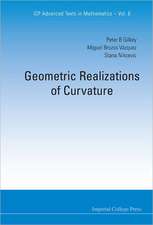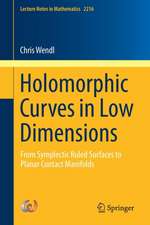Structure of Dynamical Systems: A Symplectic View of Physics: Progress in Mathematics, cartea 149
Autor J.M. Souriauen Limba Engleză Hardback – 22 sep 1997
Din seria Progress in Mathematics
- 24%
 Preț: 740.79 lei
Preț: 740.79 lei -
 Preț: 308.20 lei
Preț: 308.20 lei - 20%
 Preț: 695.88 lei
Preț: 695.88 lei -
 Preț: 362.51 lei
Preț: 362.51 lei -
 Preț: 308.13 lei
Preț: 308.13 lei - 18%
 Preț: 749.27 lei
Preț: 749.27 lei - 9%
 Preț: 766.41 lei
Preț: 766.41 lei - 20%
 Preț: 631.08 lei
Preț: 631.08 lei - 24%
 Preț: 638.86 lei
Preț: 638.86 lei - 15%
 Preț: 580.82 lei
Preț: 580.82 lei -
 Preț: 392.37 lei
Preț: 392.37 lei -
 Preț: 395.09 lei
Preț: 395.09 lei -
 Preț: 376.80 lei
Preț: 376.80 lei -
 Preț: 390.25 lei
Preț: 390.25 lei - 18%
 Preț: 729.53 lei
Preț: 729.53 lei - 15%
 Preț: 652.49 lei
Preț: 652.49 lei - 15%
 Preț: 649.22 lei
Preț: 649.22 lei - 18%
 Preț: 897.95 lei
Preț: 897.95 lei -
 Preț: 385.08 lei
Preț: 385.08 lei -
 Preț: 391.02 lei
Preț: 391.02 lei -
 Preț: 378.54 lei
Preț: 378.54 lei - 15%
 Preț: 531.59 lei
Preț: 531.59 lei - 15%
 Preț: 642.83 lei
Preț: 642.83 lei - 15%
 Preț: 650.69 lei
Preț: 650.69 lei -
 Preț: 381.21 lei
Preț: 381.21 lei -
 Preț: 392.37 lei
Preț: 392.37 lei -
 Preț: 398.53 lei
Preț: 398.53 lei - 15%
 Preț: 699.28 lei
Preț: 699.28 lei -
 Preț: 416.92 lei
Preț: 416.92 lei -
 Preț: 385.84 lei
Preț: 385.84 lei - 18%
 Preț: 902.65 lei
Preț: 902.65 lei - 18%
 Preț: 802.28 lei
Preț: 802.28 lei - 15%
 Preț: 640.06 lei
Preț: 640.06 lei - 18%
 Preț: 1129.83 lei
Preț: 1129.83 lei - 15%
 Preț: 494.03 lei
Preț: 494.03 lei - 15%
 Preț: 593.08 lei
Preț: 593.08 lei
Preț: 914.06 lei
Preț vechi: 1202.70 lei
-24% Nou
Puncte Express: 1371
Preț estimativ în valută:
174.94€ • 181.93$ • 146.39£
174.94€ • 181.93$ • 146.39£
Carte tipărită la comandă
Livrare economică 11-17 martie
Preluare comenzi: 021 569.72.76
Specificații
ISBN-13: 9780817636951
ISBN-10: 0817636951
Pagini: 406
Ilustrații: 1
Dimensiuni: 155 x 235 x 27 mm
Greutate: 1.76 kg
Ediția:1997
Editura: Birkhäuser Boston
Colecția Birkhäuser
Seria Progress in Mathematics
Locul publicării:Boston, MA, United States
ISBN-10: 0817636951
Pagini: 406
Ilustrații: 1
Dimensiuni: 155 x 235 x 27 mm
Greutate: 1.76 kg
Ediția:1997
Editura: Birkhäuser Boston
Colecția Birkhäuser
Seria Progress in Mathematics
Locul publicării:Boston, MA, United States
Public țintă
ResearchDescriere
It
is
with
great
pleasure
that
we
are
able
to
provide
the
reader
with
a
translation
of
Souriau's
elassical
text
"Structure
des
Systemes
Dy
namiques"
on
mechanics.
We
have
added
the
subtitle
"a
symplectic
view
of
physics",
which
is
elose
to
the
title
first
proposed
by
the
author.
Compared
to
the
French
version,
we
have
made
several
changes
in
nota
tion
for
the
English
edition,
all
of
which
have
the
author's
approval.
The
most
important
change
is
that
the
symbol
V'
for
the
exterior
derivative
of
differential
forms
has
been
replaced
by
the
symbol
d.
Consequently
in
order
to
avoid
confusion,
the
symbols
d,
d',
...
for
vector
fields
have
been
replaced
by
8,
8',
....
We
warn
the
reader
that
differential
forms
are
always
given
in
terms
of
their
action
on
tangent
vectors
and
not
in
2
terms
of
a
dual
basis.
We
use
this
opportunity
to
thank
C.
Sacn§
of
the
University
of
Lille
I
for
doing
all
the
computer
graphics.
Cuprins
I.
Differential
Geometry.-
§1.
Manifolds.-
The
definition
of
a
manifold.-
Open
sets.-
Differentiable
maps.-
The
tangent
space.-
Submanifolds.-
Manifolds
defined
by
an
equation.-
Covering
spaces.-
Quotient
manifolds.-
Connectedness.-
Homotopy.-
§2.
Derivations.-
Variables.-
Vector
fields
and
derivations.-
Derivations
of
linear
operators.-
The
image
of
a
vector
field.-
Lie
brackets.-
§3.
Differential
equations.-
The
exponential
of
a
vector
field.-
The
image
of
a
differential
equation.-
The
derivative
of
the
exponential
map.-
§4.
Differential
forms.-
Covariant
fields.-
The
inverse
image
of
a
covariant
field.-
The
Lie
derivative.-
Covariant
tensor
fields.-
p-
Forms.-
The
exterior
derivative.-
§5.
Foliated
manifolds.-
Foliations.-
The
quotient
of
a
manifold
by
a
foliation.-
Integral
invariants.-
The
characteristic
foliation
of
a
form.-
§6.
Lie
groups.-
Actions
of
a
Lie
group
on
a
manifold.-
The
Lie
algebra
of
a
Lie
group.-
Orbits.-
The
adjoint
representation.-
Lie
subalgebras
and
Lie
subgroups.-
The
stabilizer.-
Classical
examples
of
Lie
groups.-
Euclidean
spaces.-
Matrix
realizations.-
§7.
The
calculus
of
variations.-
Classical
variational
problems.-
Canonical
variables.-
The
Hamiltonian
formalism.-
A
geometrical
interpretation
of
the
canonical
equations.-
Transformations
of
a
variational
problem.-
Noether’s
theorem.-
II.
Symplectic
Geometry.-
§8.
2-Forms.-
Orthogonality.-
Canonical
bases.-
The
symplectic
group.-
§9.
Symplectic
manifolds.-
Symplectic
and
presymplectic
manifolds.-
Symplectic
structures
arising
from
a
1-form.-
Poisson
brackets.-
Induced
symplectic
structures.-
§10.
Canonical
transformations.-
Canonical
charts.-
Canonical
transformations.-
Canonical
similitudes.-
Covering
spaces
of
symplectic
manifolds.-
Infinitesimal
canonical
transformations.-
§11.
Dynamical
Groups.-
The
definition
of
a
dynamical
group.-
The
cohomology
of
a
dynamical
group.-
The
cohomology
of
a
Lie
group.-
The
cohomology
of
a
Lie
algebra.-
Symplectic
manifolds
defined
by
a
Lie
group.-
III.
Mechanics.-
§12.
The
geometric
structure
of
classical
mechanics.-
Material
points.-
Systems
of
material
points.-
Constraints.-
Describing
forces.-
The
evolution
space.-
Phase
spaces
and
the
space
of
motions.-
The
Lagrange
2-form.-
The
Lagrange
form
for
constrained
systems.-
Changing
the
reference
frame.-
The
principle
of
Galilean
relativity.-
Maxwell’s
principle.-
Potentials
and
the
variational
formalism.-
Geometric
consequences
of
Maxwell’s
principle.-
An
application:
variation
of
constants.-
Galilean
moments.-
Remarks.-
Examples
of
dynamical
groups.-
§13.
The
principles
of
symplectic
mechanics.-
Nonrelativistic
symplectic
mechanics.-
Moments,
mass,
and
the
center
of
mass.-
The
center
of
mass
decomposition.-
Minkowski
space
and
the
Poincaré
group.-
Relativistic
mechanics.-
§14.
A
mechanistic
description
of
elementary
particles.-
Elementary
systems.-
A
particle
with
spin.-
Remarks.-
A
particle
without
spin.-
A
massless
particle.-
Remarks.-
Nonrelativistic
particles.-
Mass
and
barycenter
of
a
relativistic
system.-
Inversions
of
space
and
time.-
A
particle
with
nonzero
mass.-
A
massless
particle.-
§15.
Particle
dynamics.-
A
material
point
in
an
electromagnetic
field.-
A
particle
with
spin
in
an
electromagnetic
field.-
Systems
of
particles
without
interactions.-
Interactions.-
Scattering
theory.-
Bounded
scattering
sources.-
Geometrical
optics.-
Planar
mirrors.-
Collisions
of
free
particles.-
IV.
Statistical
Mechanics.-
§16.
Measures
on
a
manifold.-
Composite
manifolds.-
Compact
sets.-
Riesz
spaces.-
Measures.-
The
tensor
product
of
measures.-
Examples
of
measures.-
Completely
continuous
measures.-
Examples
of
completely
continuous
measures.-
The
support
of
a
measure.-
Bounded
measures.-
Integrable
functions.-
The
image
of
a
measure.-
Examples.-
Random
variables.-
Average
values.-
Entropy
and
Gibbs
measures.-
The
Gibbs
canonical
ensemble
of
a
dynamical
group.-
§17.
The
principles
of
statistical
mechanics.-
Statistical
states.-
Hypotheses
of
the
kinetic
theory
of
gases.-
Equilibria
of
a
conservative
system.-
Ideal
gases.-
A
monatomic
ideal
gas.-
An
arbitrary
ideal
gas.-
An
ideal
gas
thermometer.-
Heat
and
work.-
Specific
heat.-
Covariant
statistical
mechanics.-
Examples.-
The
statistical
equilibrium
of
an
isolated
system.-
Relativistic
statistical
mechanics.-
A
relativistic
ideal
gas.-
Statistical
equilibria
of
photons.-
V.
A
Method
of
Quantization.-
§18.
Geometric
quantization.-
Prequantum
manifolds.-
Prequantization
of
a
symplectic
manifold.-
Prequantization
of
a
symplectic
manifold
admitting
a
potential.-
Prequantization
of
a
sphere
S2.-
Prequantization
by
“fusion”.-
Prequantization
of
a
direct
product.-
Prequantization
of
a
relativistic
particle
with
spin
½.-
Prequantization
of
a
massless
particle.-
Massless
particle
with
spin
½.-
Massless
particle
with
spin
1.-
Planck
manifolds.-
Quantomorphisms.-
Homotopy
and
prequantization.-
Systems
of
elementary
particles.-
Infinitesimal
quantomorphisms.-
Quantization
of
dynamical
groups.-
The
Hilbert
space
of
a
prequantum
manifold.-
§19.
Quantization
of
dynamical
systems.-
The
correspondence
principle.-
State
vectors
and
observables.-
The
formulation
of
Planck’s
condition.-
Stationary
states.-
The
formation
of
wave
equations.-
The
nonrelativistic
material
point.-
The
relativistic
material
point.-
The
nonrelativistic
particle
with
spin
½.-
The
relativistic
particle
with
spin
½.-
The
massless
particle
with
spin
½.-
The
massless
particle
with
spin
1.-
Assemblées
of
particles.-
Creation
and
annihilation
operators.-
Quantum
states.-
List
of
notation.
Textul de pe ultima copertă
This
book
is
addressed
to
graduate
students
and
researchers
in
mathematics
and
physics
who
are
interested
in
mathematical
and
theoretical
physics,
symplectic
geometry,
mechanics,
and
(geometric)
quantization.
The aim of the book is to treat all three basic theories of physics, namely, classical mechanics, statistical mechanics, and quantum mechanics from the same perspective, that of symplectic geometry, thus showing the unifying power of the symplectic geometric approach. Reading this book will give the reader a deep understanding of the interrelationships between the three basic theories of physics.
The first tow chapters provide the necessary mathematical background in differential geometry, Lie groups, and symplectic geometry. In Chapter 3 a coherent symplectic description of Galilean and relativistic mechanics is given, culminating in the classification of elementary particles (relativistic and non-relativistic, with or without spin, with or without mass). In Chapter 4 statistical mechanics is put into symplectic form, finishing with a symplectic description of the kinetic theory of gases and the computation of specific heats. Finally, in Chapter 5 the author presents his theory of geometric quantization. Highlights of this chapter are the derivations of various wave equations and the construction of the Fock space.
The aim of the book is to treat all three basic theories of physics, namely, classical mechanics, statistical mechanics, and quantum mechanics from the same perspective, that of symplectic geometry, thus showing the unifying power of the symplectic geometric approach. Reading this book will give the reader a deep understanding of the interrelationships between the three basic theories of physics.
The first tow chapters provide the necessary mathematical background in differential geometry, Lie groups, and symplectic geometry. In Chapter 3 a coherent symplectic description of Galilean and relativistic mechanics is given, culminating in the classification of elementary particles (relativistic and non-relativistic, with or without spin, with or without mass). In Chapter 4 statistical mechanics is put into symplectic form, finishing with a symplectic description of the kinetic theory of gases and the computation of specific heats. Finally, in Chapter 5 the author presents his theory of geometric quantization. Highlights of this chapter are the derivations of various wave equations and the construction of the Fock space.



















